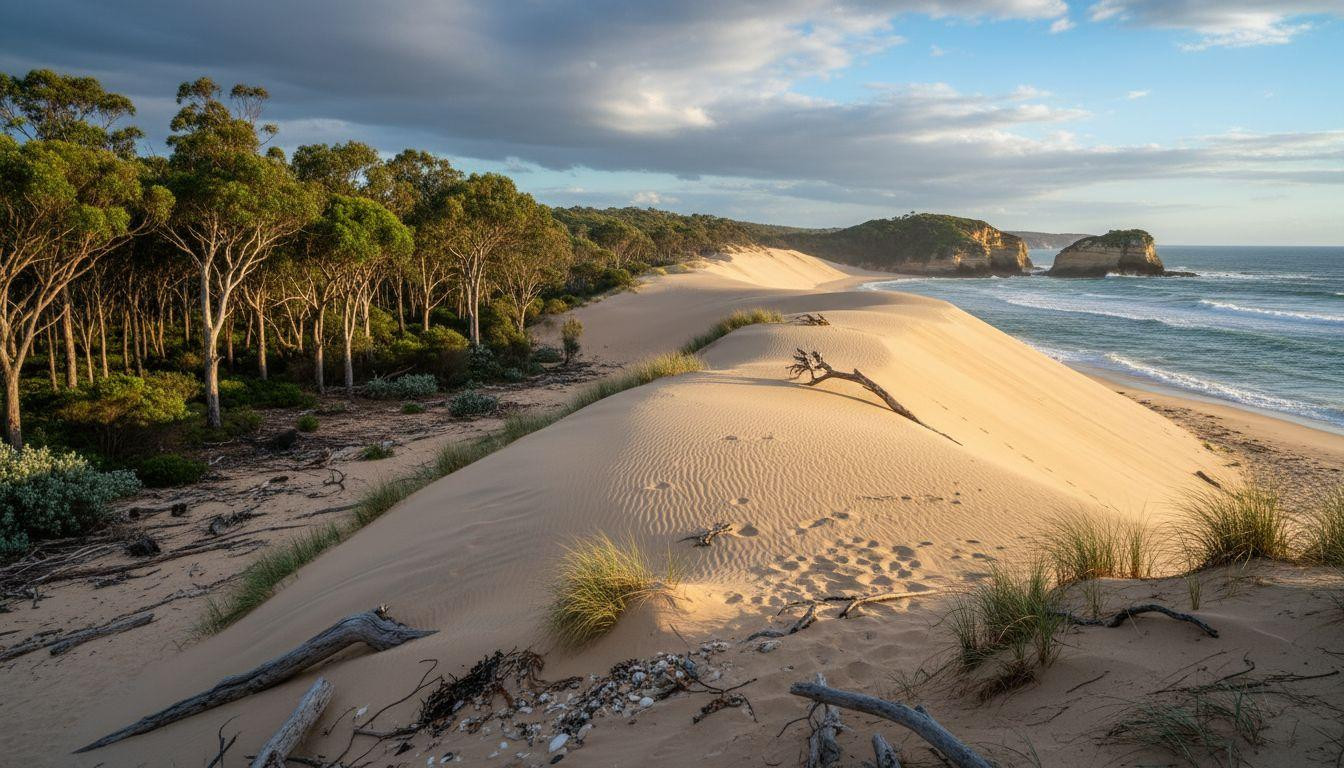Golden light spreads across 12 miles of empty beach as November warmth touches NSW’s overlooked coast. Hat Head National Park stretches where rocky cliffs meet rolling sand dunes and crystal-clear creek waters. This coastal sanctuary draws just 70,000 visitors annually while millions crowd Byron Bay 200 miles north.
Desert-like beaches dissolve into rainforest canopy here. The Pacific crashes against weathered headlands while kangaroos browse morning tracks. What makes this place extraordinary isn’t just the scenery. It’s the silence.
Where rainforest meets Pacific isolation
Hat Head sits 211 miles north of Sydney on NSW’s mid-coast. The tiny village holds 200 residents while nearby South West Rocks shelters 4,000 souls. Port Macquarie Airport lies 42 miles south with Sydney connections.
The Dunghutti people lived here for thousands of years before European settlement. Their traditional lands encompass this stretch of coast where eucalyptus forests meet ocean spray. European lighthouse keepers arrived in 1891 when Smoky Cape Lighthouse began guiding ships through treacherous waters.
November brings late spring warmth to this temperate coast. Temperatures reach 59-77°F daily while whale migration tapers toward summer. Wilson’s Promontory offers similar coastal wilderness 590 miles southeast in Victoria.
Three landscapes in one coastal sanctuary
Rocky headlands rise 65-100 feet above crashing waves. Golden sand dunes roll inland like miniature deserts. Crystal-clear Korogoro Creek winds through coastal rainforest where morning mist clings to eucalyptus branches.
Rocky headlands and the 1891 lighthouse
Smoky Cape Lighthouse stands sentinel on weathered cliffs. Two restored keeper’s cottages offer heritage accommodation from $295-425 nightly. The three-bedroom cottages house eight guests each with full kitchens and coastal views.
Heritage-listed weatherboard structures feature red roofs and wraparound verandas. Panoramic ocean vistas stretch to the horizon. Late November marks peak southern right whale sightings as mammals begin northward migration.
Golden dunes and desert beaches
Twelve miles of uninterrupted coastline stretch between rocky points. Rolling sand dunes create otherworldly landscapes where fine golden sand meets turquoise Pacific waters. Beach access requires short walks through coastal forest.
Hungry Gate campground sits surrounded by towering dunes. A 10-minute boardwalk leads to empty beaches. Rainforest meets reef experiences await 435 miles north at Cape Tribulation.
Crystal waters and wild encounters
Korogoro Creek flows crystal-clear through coastal forest. High tide brings swimming and snorkeling opportunities in fresh brackish waters. The 2-mile Korogoro walking track follows creek banks where wild kangaroos emerge at dawn.
Swimming and wildlife experiences
Creek waters stay cool year-round while ocean temperatures reach 68-72°F in November. Black swans glide across wetlands while white-bellied sea eagles soar overhead. Curlews and plovers probe tidal flats for marine worms.
Dawn wildlife encounters reward early risers. Eastern grey kangaroos browse forest edges while powerful owls call from towering eucalyptus. Echidnas shuffle through undergrowth searching for ants and termites.
Coastal activities beyond beaches
Shore fishing targets whiting, flathead and mud crabs. NSW fishing licenses cost $16-26 depending on duration. Kayak eco-tours launch from Korogoro Creek for $25-39 per person. Wild water adventures continue 186 miles inland on the Nymboida River.
Walking tracks range 1-4 miles through varied terrain. Bush tracks wind through coastal heath while beach walks extend for miles. Birdwatching peaks during morning hours when forest species are most active.
The serenity 70,000 discover annually
Soft golden light filters through coastal eucalyptus each morning. Ocean breezes carry salt spray mixed with flowering banksia scents. Rhythmic wave sounds contrast with native bird calls echoing through forest canopy.
Evening campfires crackle at two main campgrounds. Hungry Gate offers 20 campsites among towering dunes while Smoky Cape provides 20 sites below lighthouse headlands. Campsites cost just $4-6 per adult nightly plus $5 vehicle entry.
Clear Milky Way displays emerge after sunset far from city light pollution. According to regional tourism offices, Hat Head remains a little-known pocket of paradise with incredible sand dunes, tranquil rainforest and crystal-clear waters. Mountain wilderness experiences complement coastal calm 280 miles southwest in the Blue Mountains.
Your questions about Hat Head National Park answered
When should I visit and what will it cost?
October through April offers ideal weather with 59-86°F temperatures. November brings late spring warmth before summer crowds arrive in December-January. Accommodation ranges from $20-33 camping to $197-295 holiday park cabins to $295-425 lighthouse keeper’s cottages nightly.
Fresh seafood meals in South West Rocks average $12-20 per person. Kayak tours cost $25-39 while fishing licenses run $16-26 depending on duration. Park vehicle entry costs $5 daily.
How does it compare to other NSW coastal parks?
Hat Head attracts 70,000 annual visitors compared to millions at Byron Bay or Port Stephens. Accommodation costs run 10-20% below NSW coastal averages. The park uniquely combines rocky coasts, desert-like dunes and lush rainforest in one location.
Jervis Bay offers whiter sand beaches but larger crowds. Bay of Fires features dramatic orange-lichen granite but requires flights to Tasmania. Hat Head provides accessible wilderness just 4.5 hours from Sydney by car.
What makes November 2025 special for visiting?
Late November marks the end of whale watching season as southern right whales complete northward migration. Spring wildflowers bloom throughout coastal heath while temperatures warm before peak summer heat. Tourist numbers remain 30-40% below December-January levels.
November weather stays mild and comfortable for camping, bushwalking and beach activities. Water temperatures rise toward summer levels while avoiding holiday weekend crowds that arrive in December.
Sunrise ignites golden dunes as kangaroos browse forest edges. Lighthouse beams sweep across darkening Pacific waters. This is the Australia coastal crowds overlook where 12 miles of solitude wait beyond the highway.
